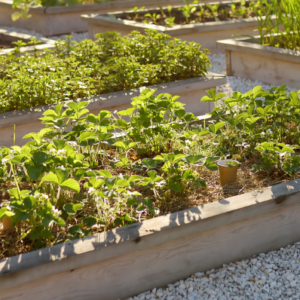By: Verenice Ramos
April signals the start of everyone’s favorite season: Spring! Many plants are already beginning to show signs of new growth along with beautiful flowers.
For those who love gardening, the beginning of this season means getting dirty and preparing the beds. Whether you need to plant a bed from scratch or renew an existing one, we have some tips that will help you to prepare your raised beds for a successful planting season.
These initial steps will lay the foundation for a successful spring season!
Raised Bed Planting Steps
1. Choose The Right Location
When choosing the location of a raised bed, you have to make sure it is in a good spot with the proper amount of sunlight for what you want to grow. Also be sure to use fertile, moist, and loose soil that is free of weeds.
2. Don’t Step On The Beds
One of the basic rules when preparing a bed for planting is to not stand inside it. The beds should have a light, spongy and well-drained soil; characteristics that favor the vigorous growth of plants. Stepping on the beds can cause the soil to become compacted and decrease aeration: a situation that would make the microorganisms within the soil unable to facilitate growth.
Make sure you can reach each part of the bed without having to stand on it. If you need to do so, you can place a board along the bed and use it to support yourself while you work.
3. Check existing beds
Before you sow your seeds or put in your plants, it is important to inspect old beds to determine what needs to be done. Beds often get wet in winter, making the soil heavy and difficult to work. There may also be loose corners or rotten wood that needs to be repaired or replaced. Make sure all of these concerns are addressed before starting any planting.
4. Remove roots and weeds that want to take over your beds
Roots are attracted to fertile, moist soil, so it is necessary to trace them to their source and pull them out to prevent them from taking over the beds. If you have any trees near your beds, you can dig to detect the potential invasion and contain it in time. Don’t forget to remove brush and weeds so your beds are completely cleared and ready for planting.
5. Check if the floor of the beds needs a refresh
Many times, winter causes the beds to compact and considerably reduce their volume. In these cases the soil can be fluffed up with a peat of straw and organic material. If your bed is settled, it will be necessary to load it with fertile, light, and crumbly soil until it reaches the desired height, then a thin layer of mulch can be placed before planting and after planting more mulch can be placed so that the beds are completely stuffed. Mulch should be applied around, but not over the mass of roots sprouting from each plant.
Once the soil is ready, tilling and composting will be the next step, Cantrell Gardens has natural fertilizers that can help with this part of the process to make your plants grow healthy and strong!
Covering the ground in your raised bed is a good practice to have year-round. It is especially useful in early spring.
The cover helps retain heat, which helps the amendments break down and “cure” before planting seeds or transplanting starters. The cover also serves to shed water, so your amendments don’t get washed away by heavy spring rains.
If you plan to plant tall crops such as tomatoes and peppers, you can put stakes or posts to facilitate their vertical support.
6. Don’t plant too early
Planting is recommended when soil temperatures are warm enough and reach 60°F (15°C). 68 to 80 degrees F (20 to 30 degrees C) is optimal.
Planting with soil that is too wet will cause your seeds to suffocate and rot. It could also risk losing their natural air pockets.
Vegetables typically will do best when the soil temperature is higher, for example 75 degrees F.
Remember that at Cantrell Gardens you can find many plants and seeds that will look great in your garden.
Although preparing the beds for spring may seem like a difficult job, by following these recommendations you will be able to do it efficiently. Plus, year-round garden maintenance will make your early spring chores easier.
The time you invest in your garden will pay off when your plants produce beautiful fruit and flowers for your family and neighbors to enjoy!
At Cantrell Gardens we can answer your gardening questions. Call us at (501) – 225-1030 or come visit us in person.
See you next time!

